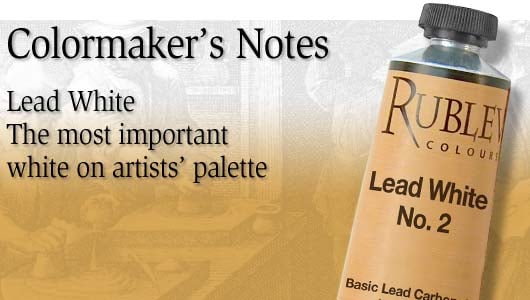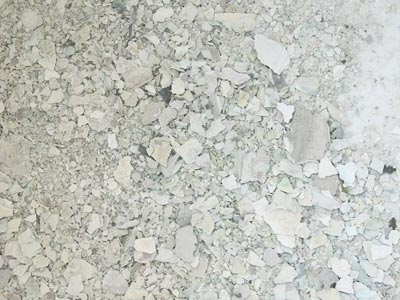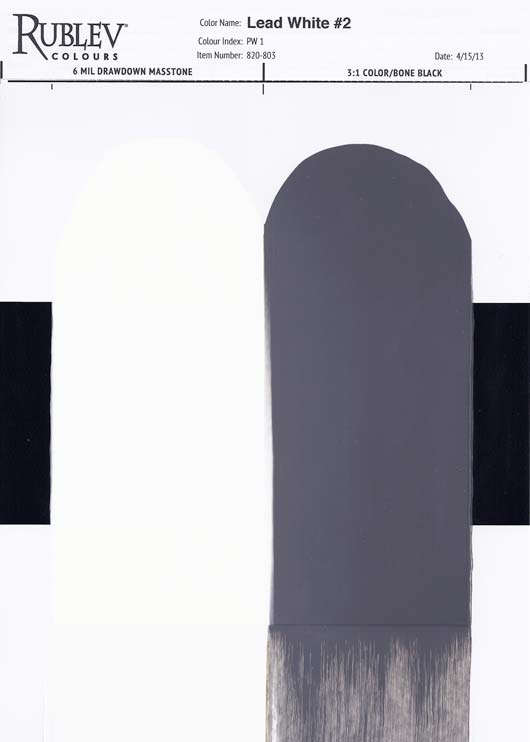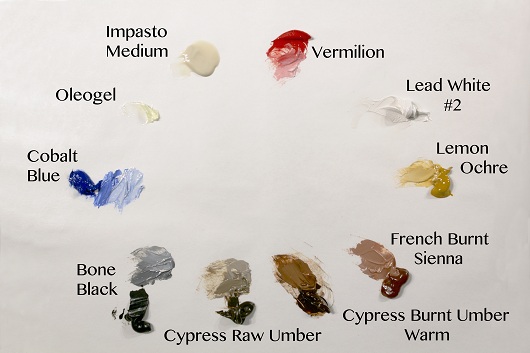|

Importance in History
Lead white is the most important white pigment used in painting throughout history. It was known to the ancient Egyptians, Greeks and Romans and commonly used in the preparation of ointments and plasters, as well as cosmetics. It was first identified in literature as a pigment by Pliny, who mentions it, among other colors, as used by the ancients to paint ships.
The density of lead white and its opacity are very important to painters. If lead white were not dense and opaque, it would be necessary to put it on thickly where, since it is both dense and opaque, a thin coat of it will serve. The power that is gives of making strokes of light as incisive as strokes of dark is fundamental to the technique of painting.
Composition and Importance in Oil Paint
Lead white oil paint is made by grinding basic lead carbonate (the chemical name for lead white pigment) in vegetable drying oil. Normal lead carbonate (PbCO3) or other lead carbonate compounds have at times been mistakenly identified as basic lead carbonate, which has the chemical formula 2PbCO3•Pb(OH)2. The other varieties of lead carbonate have not been reported in paintings, except as impurities. Basic lead carbonate contains from 25 to 30 percent lead hydroxide, which distinguishes it from normal lead carbonate. It is this element that gives added opacity to lead white. It also gives it the qualities in oil paint often sought after by artists.
Lead white also serves to preserve the flexibility of oil paint, extending the life of the paint film. In a posting on the AMIEN forum, Dr. Jaap Boon, University of Amsterdam and AMOLF and formerly head of the MolArt Project, offered these important insights into the role of lead white in oil paint film:
“The role of lead white is multiple. It is a bulk drier that means homogenous drying over the paint film. It reacts with free acids that develop by oxidation of the oil. It links the acids groups of C9 diacids even when they are still acylglycerides thus stabilising the early film (proven by NMR work of Michiel Verhoeven in 2006). At a later stage when the biological ester bonds are gone, it further stabilises the diacids to form a network that is hard to break. And furthermore, it provides a filling material and surfaces for oil-derived compounds to dock.”
“No lead means that something else has to take over these roles. I don't think that that magical material has been found yet simply because we only very recently have begun to understand the molecular structure of paints. It is my belief that the period 1950–2000 will bring us many defects in the oil paints that are now maturing. It is time that we develop a molecular level understanding on how to deal with oil paint defects that develop when the network can't be stabilised with suitable metal cations.”
Why “Flake White” and “Cremnitz White” for Lead White
When you see a tube of oil paint labeled “flake white” or “Cremnitz white,” what pigment does it contain? What most artists material manufacturers call flake white is a mixture of basic lead carbonate and zinc oxide ground in vegetable oil (usually linseed or safflower). Cremnitz white, on the other hand, is usually pure basic lead carbonate ground in vegetable oil.
Lead white has been made since antiquity using variations of the process known as the “stack process” or “Old Dutch” method whereby lead is exposed to acetic acid vapor in the presence of moisture and carbon dioxide; the latter is generally provided by fermenting matter (horse manure, waste grape skins, tan bark), which also provides a constant source of heat. In this process, the air supplies the oxygen, while the fermenting matter gives off carbon dioxide and moisture. The acetic acid, in the form of vinegar, converts the lead, forming basic or tribasic lead acetate, which is afterwards decomposed by the carbon dioxide to form basic lead carbonate. The stack process and its related Krems process are different from methods used to manufacture basic lead carbonate today, which are based on an electrolytic process. The results of the Dutch and Krems methods is basic lead carbonate, but the size and shape of the pigment particle is quite different, giving these whites different properties in paint. A more detailed discussion of the stack process can be found in Stack Process White Lead—Historical Method of Manufacture.
 The term flake white takes its name from the scales or flakes (see right) of basic lead carbonate that appear on corroded lead in the stack process or old Dutch method of making the pigment. The modern electrolytic process does not result in flakes of basic lead carbonate, but rather the pigment deposits as a fine precipitate. The particle size and morphology (crystal structure and particle shape) of stack process lead white is a critical factor that makes this pigment different to modern lead white. The term flake white takes its name from the scales or flakes (see right) of basic lead carbonate that appear on corroded lead in the stack process or old Dutch method of making the pigment. The modern electrolytic process does not result in flakes of basic lead carbonate, but rather the pigment deposits as a fine precipitate. The particle size and morphology (crystal structure and particle shape) of stack process lead white is a critical factor that makes this pigment different to modern lead white.
 More about Stack Process White Lead More about Stack Process White Lead
The name Cremnitz white is a variant spelling of Kremnitz, which is derived from the German name of the Slovak town Kremnica. This town was mistakenly associated with the commercial name Kremsweiss (German) or Krems white famous in the 18th and 19th centuries. Krems white was manufactured in the city of Klangenfurt, Austria, but the name was probably derived from the galena (a lead ore) mines near the small town in lower Austria, Krems, now called Krems an der Donau. Krems white was deemed to be superior to any other lead white during the 19th century, and it is perhaps this reason why artists’ materials manufacturers chose this name to designate their pure lead white oil paint.
 Rublev Colours Lead White #2 Rublev Colours Lead White #2
Rublev Colours Lead White #2 is an opaque white that is soft and ropy or “stringy.” The ropy consistency of Lead White #2, also called “long”, is a result of using walnut oil without additives. Long paint pulls with the brush and for this reason is often preferred by artists, because it flows with your brushstroke enabling long lines. This effect can be seen in the image at right. Lead White #2 is a brighter white than Rublev Colours Lead White, because it is ground in filtered, pale walnut oil.
Because Rublev Colours Lead White #2 is ground with basic lead carbonate made according to modern practice, we chose to name it “Lead White,” so as not to confuse artists with lead whites made according the stack process or Krems process named “Flake White” and “Krems White,” respectively.

The image above is a “drawdown” of Rublev Colours Lead White #2 oil paint. The left drawdown is the color full strength at 3 mil (0.003 inch) thickness over a black and white chart. The right drawdown is one part of the color mixed with three parts of bone black. The bottom edges of the drawdowns were scraped to show the color of the undertone.
Additives are used in modern oil paint to help prevent the pigment and oil from separating during storage and as an aid in grinding the paint. Rublev Colours Lead White #2 contains basic lead carbonate (made according to modern processes) without additives or fillers to alter the characteristics of the pigment in oil. As a result you get higher pigment volume concentration (PVC) than other brands of lead white (flake white)—as high as 45%. This means most brands of flake white do not weigh nearly as much as a 50 ml tube of Rublev Colours Lead White #2. Yet, Rublev Colours Lead White is not stiff and mixes well with all other oil colors.
Additives used by all other manufacturers include beeswax, hydrogenated castor oil, and aluminum or magnesium stearate. These ingredients amount from one to two percent of the pigment weight in the formula. Although this is a comparatively small amount, additives change the behavior of the pigment in oil, because they increase the viscosity of the oil, giving the paint a buttery, short consistency.
Rublev Colours Artists Oils are traditional oil paints, because they are made according to historical methods, such as those in the 19th century, when modern additives were not used in artists paint. Rublev Colours use traditional pigments, so you will not find pigments invented after the rise of modern industry, such as cadmiums, pthalos, quinacridones, etc., in our colors.
 More about Rublev Colours Lead White #2 Artists Oil More about Rublev Colours Lead White #2 Artists Oil
Painting by Candice Bohannon
Candice Bohannon shared with us how she uses Rublev Colours oil paints and mediums in her latest painting, Ice Flow.
“For the painting Ice Flow I used a palette consisting primarily of Rublev Colours. Though my palette changes from one painting to another, constantly undergoing slight changes as I intuitively respond to the needs of my subject, the fur in Ice Flow was painted with a palette of: Lead White #2, Bone Black, French Burnt Sienna, Lemon Ocher, Cypress Burnt Umber Warm, Cypress Raw Umber, Cobalt Blue (the only non Rublev Colours artists oil) and touches of Vermilion. All of the colors shown here were used pretty much just as they were, straight from the tube with the addition of white as needed. The exception to that was with the Cobalt Blue and Vermilion, as I used those sparingly in mixes with the other colors when I wished to utilize them in the palette.”

The palette for the fur in Candice Bohannon’s painting Ice Flow shows her approach to mixing tints with Rublev Colours Artists Oils.
“The palette used for the flesh tones in Ice Flow was slightly different to that of the fur palette: Lead White #2, Vermilion, French Burnt Sienna, Orange Ocher, Lemon Ocher, Cypress Burnt Umber Warm, Cypress Raw Umber, Bone Black, Antica Green Earth, Cobalt Blue and Thio Violet (the latter two are not by Rublev Colours).”

Candice Bohannon’s painting Ice Flow
“When painting onto a dried paint layer, I rub a very thin layer of Rublev Colours Oleogel on the surface of the painting to “oil out” the area that I am working on that day. It works wonders, making the new paint glide over the dried layer with the ease of wet into wet paint. I used Rublev Colours Velasquez Medium and Impasto Medium at times to play with texture within the paint layers, but Rublev Colours artists oils have such a variety of textures inherent to each color that many wonderful paint effects occur naturally through the healthy application of the paint straight from the tube. I have come to depend on Rublev Colours’ ropy and textural Lead White #2—it is the most essential tube of paint I own and can be reliably used to great effect in any palette I am using.”

About Candice Bohannon
Candice Bohannon is an American contemporary representational artist. She was born in Sacramento, California in 1982. Raised in the rural forested landscape of the foothills of the Sierra Nevada mountains, her naturalistic aesthetic in art was honed from an early age. After high school, Candice enrolled in art college, and after intense studies in painting, drawing, sculpting, art history, philosophy and aesthetics, she graduated from the Laguna College of Art and Design in 2005 with a BFA in painting/drawing and a minor in sculpture. It was there at LCAD that Candice met her future husband, fellow artist and best friend, Julio Reyes. After nearly 10 years in southern California, they moved back to rural northern California where they currently reside. More of Candice’s work can be seen at www.candicebohannon.com.
|